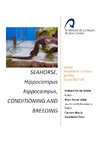Please use this identifier to cite or link to this item:
https://accedacris.ulpgc.es/handle/10553/75006
| Title: | Seahorse, Hippocampus hippocampus, conditioning and breeding | Authors: | Ferrer Vidal, Marc | Director: | Hernández Cruz, Carmen María | UNESCO Clasification: | 251092 Acuicultura marina | Keywords: | Hippocampus hippocampus | Issue Date: | 2018 | Abstract: | The destruction of natural habitat of Hippocampus hippocampus and the strong pressure on natural populations for ornamental, aquariology and traditional Chinese medicine, and the low newborns survival in captivity, represent a bottleneck for a massive production of this species and make seahorses situation delicate. The massive production of H. hippocampus could be one of the palliative measures to maintain the biodiversity and could relieve the pressure on natural populations due to the high market demand of aquarist, fisheries and natural medicinal sectors. An aquarium placed in the Marina of Ibiza, Ibiza, Balearic Islands, Spain with 12 individuals of H. hippocampus, six adults and six juveniles (4 months old from the last litter) was conditioned to offer the optimal conditions for his survival, breeding, mating and reproduction. During the experimental season, feeding, aquarium and skimmer cleaning and water parameters, temperature (ºC), salinity (‰), pHt, inorganic [NO3 -][mg/l], inorganic [PO4 3-][mg/l] and aquarium water change were controlled. Data was saved in a diary to realize which aquarium conditions, food preference and water parameters levels were the best for our objective. The seahorse’s preferences of settlement/habitat were also experimented between Posidonia oceanica, Caulerpa racemosa, and MAERL or coralline red algae in order to fill the aquariums up of the future selling project with the specie resulted more useful for H. hippocampus. To design a future selling project of larvae and reproducers of H. hippocampus the results obtained throughout these four experimental months were considered. Unfortunately, neither mating nor reproduction was achieved during the experiment and 7 seahorses died for different reasons reaching a total mortality of 58% commented in Discussion. | Department: | Departamento de Biología | Faculty: | Facultad de Ciencias del Mar | Degree: | Grado en Ciencias del Mar | URI: | https://accedacris.ulpgc.es/handle/10553/75006 |
| Appears in Collections: | Trabajo final de grado Restringido ULPGC |
En el caso de que no encuentre el documento puede ser debido a que el centro o las/os autoras/es no autorizan su publicación. Si tiene verdadero interés en el contenido del mismo, puede dirigirse al director/a o directores/as del trabajo cuyos datos encontrará más arriba.
Show full item recordPage view(s)
143
checked on Nov 1, 2024
Download(s)
40
checked on Nov 1, 2024
Google ScholarTM
Check
Share
Export metadata
Items in accedaCRIS are protected by copyright, with all rights reserved, unless otherwise indicated.
